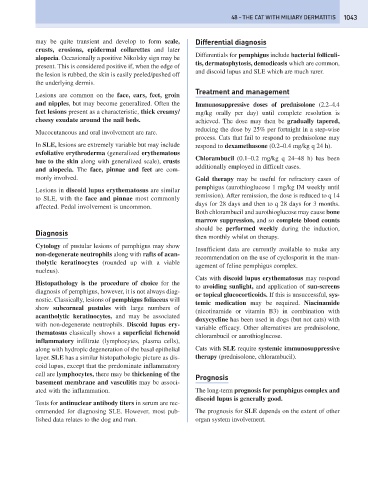Page 1051 - Problem-Based Feline Medicine
P. 1051
48 – THE CAT WITH MILIARY DERMATITIS 1043
may be quite transient and develop to form scale, Differential diagnosis
crusts, erosions, epidermal collarettes and later
Differentials for pemphigus include bacterial folliculi-
alopecia. Occasionally a positive Nikolsky sign may be
tis, dermatophytosis, demodicosis which are common,
present. This is considered positive if, when the edge of
and discoid lupus and SLE which are much rarer.
the lesion is rubbed, the skin is easily peeled/pushed off
the underlying dermis.
Treatment and management
Lesions are common on the face, ears, feet, groin
and nipples, but may become generalized. Often the Immunosuppressive doses of prednisolone (2.2–4.4
feet lesions present as a characteristic, thick creamy/ mg/kg orally per day) until complete resolution is
cheesy exudate around the nail beds. achieved. The dose may then be gradually tapered,
reducing the dose by 25% per fortnight in a step-wise
Mucocutaneous and oral involvement are rare.
process. Cats that fail to respond to prednisolone may
In SLE, lesions are extremely variable but may include respond to dexamethasone (0.2–0.4 mg/kg q 24 h).
exfoliative erythroderma (generalized erythematous
Chlorambucil (0.1–0.2 mg/kg q 24–48 h) has been
hue to the skin along with generalized scale), crusts
additionally employed in difficult cases.
and alopecia. The face, pinnae and feet are com-
monly involved. Gold therapy may be useful for refractory cases of
pemphigus (aurothioglucose 1 mg/kg IM weekly until
Lesions in discoid lupus erythematosus are similar
remission). After remission, the dose is reduced to q 14
to SLE, with the face and pinnae most commonly
days for 28 days and then to q 28 days for 3 months.
affected. Pedal involvement is uncommon.
Both chlorambucil and aurothioglucose may cause bone
marrow suppression, and so complete blood counts
should be performed weekly during the induction,
Diagnosis
then monthly whilst on therapy.
Cytology of pustular lesions of pemphigus may show
Insufficient data are currently available to make any
non-degenerate neutrophils along with rafts of acan-
recommendation on the use of cyclosporin in the man-
tholytic keratinocytes (rounded up with a viable
agement of feline pemphigus complex.
nucleus).
Cats with discoid lupus erythematosus may respond
Histopathology is the procedure of choice for the
to avoiding sunlight, and application of sun-screens
diagnosis of pemphigus, however, it is not always diag-
or topical glucocorticoids. If this is unsuccessful, sys-
nostic. Classically, lesions of pemphigus foliaceus will
temic medication may be required. Niacinamide
show subcorneal pustules with large numbers of
(nicotinamide or vitamin B3) in combination with
acantholytic keratinocytes, and may be associated
doxycycline has been used in dogs (but not cats) with
with non-degenerate neutrophils. Discoid lupus ery-
variable efficacy. Other alternatives are prednisolone,
thematosus classically shows a superficial lichenoid
chlorambucil or aurothioglucose.
inflammatory infiltrate (lymphocytes, plasma cells),
along with hydropic degeneration of the basal epithelial Cats with SLE require systemic immunosuppressive
layer. SLE has a similar histopathologic picture as dis- therapy (prednisolone, chlorambucil).
coid lupus, except that the predominate inflammatory
cell are lymphocytes, there may be thickening of the
Prognosis
basement membrane and vasculitis may be associ-
ated with the inflammation. The long-term prognosis for pemphigus complex and
discoid lupus is generally good.
Tests for antinuclear antibody titers in serum are rec-
ommended for diagnosing SLE. However, most pub- The prognosis for SLE depends on the extent of other
lished data relates to the dog and man. organ system involvement.

